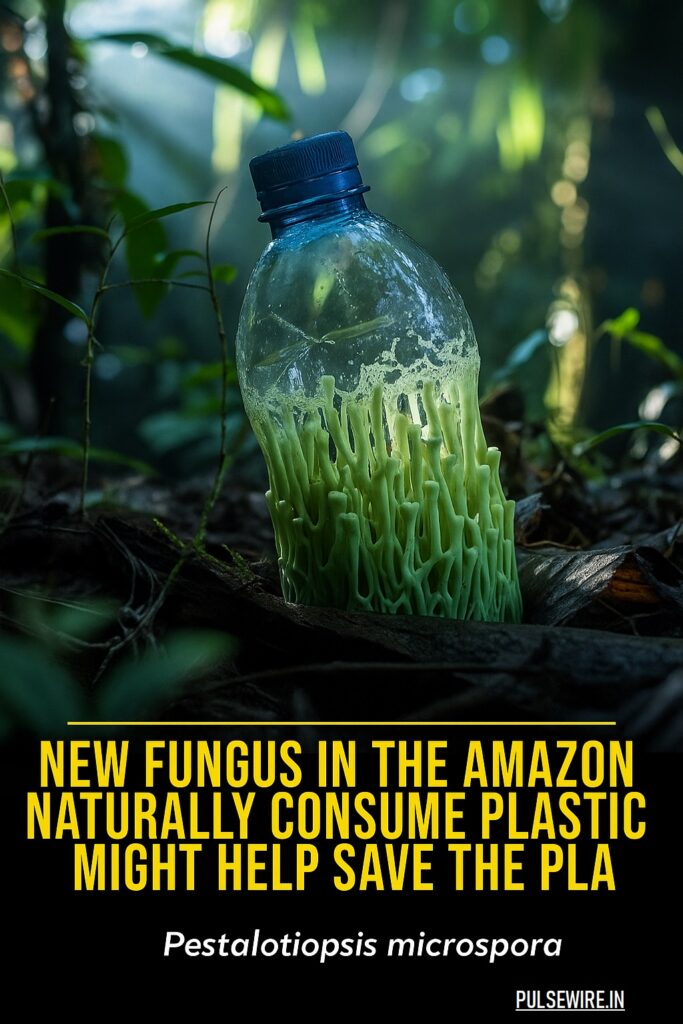Author: Pulsewire Science Desk

Published: July 15, 2025
In the heart of the Amazon rainforest, scientists made a discovery that could revolutionize how we handle one of humanity’s biggest environmental threats: plastic pollution. A fungus named Pestalotiopsis microspora was found to possess the extraordinary ability to digest and survive solely on plastic—specifically polyurethane—even in environments devoid of oxygen.
🧬 What Is Pestalotiopsis microspora?
Pestalotiopsis microspora is an endophytic fungus, meaning it typically lives inside plant tissues without harming its host. It was discovered during a 2011 expedition by a group of Yale University undergraduates led by Professor Scott Strobel. The students were part of a rainforest expedition designed to uncover unique microbial organisms with potential industrial or environmental applications.
What they found was groundbreaking: a fungus that could not only tolerate polyurethane—a highly resistant synthetic polymer—but actually use it as a sole source of carbon and energy [ACS Environmental Science & Technology, 2011].
🌍 Why Is Polyurethane Such a Problem?
Polyurethane is widely used in foams, coatings, adhesives, insulation, and countless consumer products. Its complex chemical structure makes it extremely difficult to biodegrade. Most polyurethane ends up in landfills, where it can persist for decades or longer. Traditional recycling methods are ineffective, and burning it releases toxic fumes, including isocyanates and hydrogen cyanide.
Unlike other fungi or bacteria that require oxygen and light to begin breaking down plastic, Pestalotiopsis microspora can operate anaerobically—meaning it can survive and break down plastic even deep within oxygen-poor landfill environments.
🔬 How the Fungus Breaks Down Plastic
The fungus secretes specific enzymes, including serine hydrolases and esterases, that are capable of cleaving the chemical bonds in polyurethane. These enzymes break down the long polymer chains into smaller, more digestible compounds, which the fungus then absorbs and uses for growth.
What’s even more remarkable is that this process occurs without requiring special lab conditions. According to researchers, the plastic degradation was observed both in standard laboratory cultures and in simulated landfill conditions [Nature News, 2011].
🧭 Environmental Applications and Potential
Harnessing this fungal ability could lead to new bioengineering technologies capable of:
- Reducing plastic volume in landfills
- Cleaning up contaminated soils and water bodies
- Supporting sustainable waste management in developing countries
- Creating fungal-based recycling bioreactors
Imagine inserting spores of this fungus into tightly packed landfills, where it could quietly work in oxygen-free layers to naturally break down plastic over time. It’s a vision that could complement—not replace—existing recycling programs, especially in regions where infrastructure is lacking.
⚠️ Limitations and Challenges
Despite its potential, several hurdles remain before this fungus becomes part of mainstream waste management:
- Speed of degradation: The plastic breakdown rate is still relatively slow compared to industrial methods.
- Scaling up: Growing and deploying fungi at a scale large enough to impact global waste is a major logistical challenge.
- Ecological safety: Introducing non-native organisms into ecosystems can have unintended consequences. Containment and regulation are essential.
- Public perception: Using living organisms in waste disposal might raise ethical or safety concerns among the public.
🔄 Synthetic Biology and Future Development
Biotechnologists are now exploring ways to extract the fungus’s plastic-degrading genes and integrate them into faster-growing microbes or enzyme systems. These genetically engineered solutions could be used in industrial-scale reactors or embedded into biodegradable materials for self-decomposition.
According to the UNEP 2023 Report on Plastic Pollution, over 430 million tons of plastic are produced annually, and only 9% is successfully recycled. Discoveries like Pestalotiopsis microspora are thus not just interesting—they are urgently needed.
📚 Scientific Community’s Response
The academic and environmental science communities have embraced this discovery as a sign that nature may still hold untapped tools to solve our manmade crises. Institutions like Yale, Stanford, and the University of São Paulo are now collaborating on research around plastic-degrading fungi and bacteria.
Meanwhile, startups and NGOs are piloting “mycoremediation” programs—using fungi to clean up oil, plastics, and heavy metals. Some projects are even combining fungi with AI systems to optimize biodegradation pathways.
🌱 Conclusion: Nature May Hold the Key
Pestalotiopsis microspora is more than just a biological curiosity. It’s a reminder that evolution may already have solutions to our most pressing environmental problems—if only we’re willing to look.
With further research, collaboration, and ethical development, this Amazonian fungus could become a key ally in humanity’s war against plastic waste.
Let’s invest in science that listens to nature.









